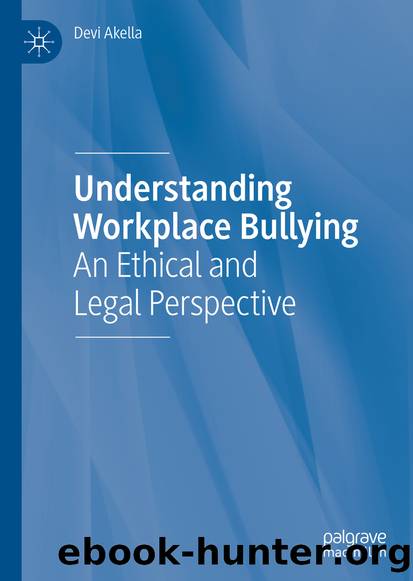Understanding Workplace Bullying by Devi Akella

Author:Devi Akella
Language: eng
Format: epub
ISBN: 9783030461683
Publisher: Springer International Publishing
7.4 Workplace Bullying Within the Education Sector
Management for the author is a contested relation, and all organizations are filled with “inequality, conflict, domination and manipulation” (Thompson & McHugh, 1995, p. 28), including higher educational institutions (Zabrodska & Kveton, 2012). In this context, management in the educational institutions is interested in student recruitment and retention, building a brand image, and meeting quality standards of accreditation agencies. All managerial activities are focused on subverting employee resistance to accomplish these goals (Baritz, 1960). This happens to be my episteme that management is a political activity with all its actions guided by the structural divisions of the society (Akella, 2003). Everything that is happening within an organization as well as the talk and behavior of faculty members and their values and beliefs should be placed within the wider political, economic, and historic contours (Alvesson & Willmott, 1992) to expose the true reality existing at these workplaces-to “expose the contradictions of the world of appearances accepted by the dominant culture as natural and unavoidable” (McLaren 1989 as cited in Kincheloe & McLaren, 1994, p. 140). The researcher is required to explore management techniques and any new forms of management control methods which may have been designed by the organization. She/he needs to inquire from the actual subjects their interpretations of their workplace and then use his/her own value judgments to interpret and analyze the empirical data.
When relatively little is known about a phenomenon, it is highly recommended to adopt a qualitative approach (Cresswell, 2003). Workplace bullying research in the area of higher education institutions is limited, thereby demanding more investigation to gain insights about the bullies, their victims, and the consequences (Carbo, 2009). In fact, all investigations on workplace bullying need to move away from “large surveys to qualitative work involving interviews and case studies. Such methodologies can gather information of a richer kind from which we can build theories and then test them” (Rayner, Hoel, & Cooper, 2002, p. 186). It was also decided as mentioned in Chap. 3 that the research methodology of dialectical phenomenology, which combined critical theory and phenomenology, would be used for all the four empirical studies mentioned in this book. This would allow the researcher to listen to the bullying incidents and bullying episodes in the words of the victims and capture glimpses of the workplaces from the visual perspectives of the victims accurately recorded in the form of verbal narratives (Richardson, 1973).
In-depth interviews would allow recording and giving visibility to the perspectives of the faculty members. The single case study approach would allow the researcher to concentrate her efforts on one college. She would be able to spend more time at the empirical site including more time with her interviewees. Case study approach is generally preferred when questions “how” and “why” need to be answered and the focus is on investigating a real-life phenomenon (Yin, 1989). Case Studies also make use of a variety of research methods such as interviews, participant observations, and surveys. This study is interested
Download
This site does not store any files on its server. We only index and link to content provided by other sites. Please contact the content providers to delete copyright contents if any and email us, we'll remove relevant links or contents immediately.
Time Management Made Easy: How to Cultivate New Habits, Improve Productivity and Get Things Done by Joshua Strachan(2366)
The 7 Habits of Highly Effective People by Stephen R. Covey & Sean Covey(2098)
The Concise Laws of Human Nature by Robert Greene(1717)
Doesn't Hurt to Ask by Trey Gowdy(1555)
Primal Leadership by Daniel Goleman(1126)
Hook Point: How to Stand Out in a 3-Second World by Brendan Kane(1098)
HBR's 10 Must Reads 2021 by unknow(1045)
Don't Sweat the Small Stuff...and It's All Small Stuff by Richard Carlson(1015)
Amazon Unbound by Brad Stone(980)
100 Things Successful People Do by Nigel Cumberland(964)
HBR's 10 Must Reads 2021 by Harvard Business Review(956)
The Job Closer by Steve Dalton(939)
Master of One by Jordan Raynor(934)
Lives of the Stoics by Ryan Holiday & Stephen Hanselman(900)
Declutter Your Mind: A step by step guide to learn to control your thoughts, stop worrying, relieve anxiety and eliminate panic attacks and negative thinking by Mia Chandler(875)
The Power of 100! by Shaun King(844)
Conflicted by Ian Leslie(798)
Coders at Work: Reflections on the craft of programming by Peter Seibel(789)
The Book of Hope by Jane Goodall(744)
